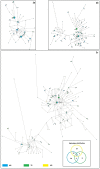New data on Weddell seal (Leptonychotes weddellii) colonies: A genetic analysis of a top predator from the Ross Sea, Antarctica
- PMID: 28796829
- PMCID: PMC5552091
- DOI: 10.1371/journal.pone.0182922
New data on Weddell seal (Leptonychotes weddellii) colonies: A genetic analysis of a top predator from the Ross Sea, Antarctica
Abstract
In this paper, we studied the genetic variability in Weddell seal from colonies in Terra Nova Bay and Wood Bay, both sites located in the Ross Sea area, Antarctica. Two mitochondrial genes and one nuclear gene, with different mutation rates, were sequenced to investigate the haplotype diversity of the colonies and to test for a possible recent expansion. Fifteen microsatellites were used to analyze their genetic structure. Sequenced genes and microsatellites were also used to estimate the effective population size of the studied colonies and the Ross Sea seal population. The Ross Sea has a high density population of Weddel seals, with an estimated effective number of 50,000 females, and 1,341 individuals for the sampling area, possibly due to its high primary production. The colonies showed high diversity (Hd > 0.90) and many exclusive haplotypes (> 75%), likely a consequence of the surprisingly high site fidelity of Weddell seals, despite the proximity of the colonies. Nevertheless, there was low microsatellite differentiation between colonies, suggesting that they are part of a single larger population. Their expansion seemed to have started during the last glacial cycle (around 58,000 years ago), indicating that the Ross Sea seal populations have been present in the area for long time, probably due to the lack of hunting by humans and terrestrial predation. As a top predator, the role of Weddell seals in the Ross Sea ecology is crucial, and its demographic dynamics should be monitored to follow the future changes of such an important ecosystem.
Conflict of interest statement
Figures





References
-
- Kooyman GL. Weddell Seal: Consummate Diver. Cambridge: Cambridge University Press; 1981.
-
- Stirling I. Ecology of the Weddell seal in McMurdo Sound, Antarctica. Ecology. 1969;50: 573–586.
-
- Laws RM. Seals and whales of the southern ocean. Philos Trans R Soc Lond. 1977;279: 81–96.
-
- Curtis C, Stewart BS, Karl SA. Pleistocene population expansions of Antarctic seals. Mol Ecol. 2009;18: 2112–2121. doi: 10.1111/j.1365-294X.2009.04166.x - DOI - PubMed
-
- Erickson AW, Hanson MB. (1990). Continental estimates and population trends of Antarctic ice seals In: Kerry KR, Hempel G, editors. Antarctic Ecosystems, Ecological Change and Conservation. Berlin and Heidelberg: Springer-Verlag; 1990. pp. 253–264.
MeSH terms
Substances
LinkOut - more resources
Full Text Sources
Other Literature Sources
Research Materials

